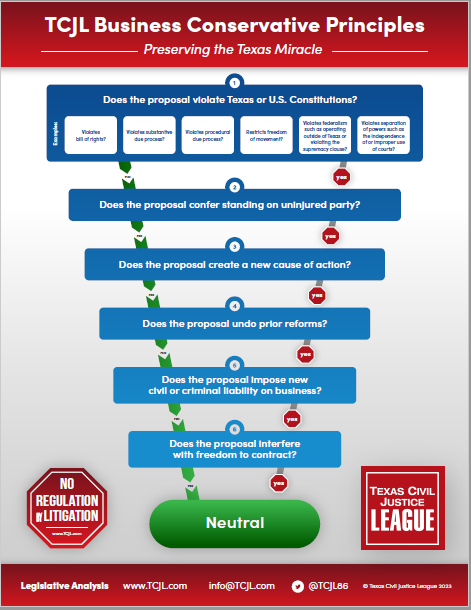
 In a case in which the Texas Medical Association and Texas Hospital Association have took opposing positions, the Texas Supreme Court has ruled that a nonprofit health organization may not be held vicarously liable for the torts of individual employee physician.
In a case in which the Texas Medical Association and Texas Hospital Association have took opposing positions, the Texas Supreme Court has ruled that a nonprofit health organization may not be held vicarously liable for the torts of individual employee physician.
Renaissance Medical Foundation v. Rebecca Lugo, Individually and as Next Friend of I.B. (No. 23-0607; May 23, 2025) arose from injuries to Plaintiff’s minor daughter allegedly caused by physician negligence during brain surgery. Plaintiff sued the physician and the physician’s employer, RMF. RMF is a nonprofit “health organization corporation” (NPHOs) certified under § 160.001(b), Texas Occupations Code, for the purpose of employing physicians to practice in affiliated hospitals. In 2011, the Texas Legislature recognized NPHOs and provided that employment agreements must reserve to physicians the “sole authority to engage in the practice of medicine.” RMF moved for summary judgment, asserting that it could not be vicariously liable for the employee-physician’s negligence because it had no control the manner in which the physician provided medical care. The trial court denied the motion but approved an accelerated permissive appeal, which the court of appeals accepted.
In an opinion by Justice Contreras, the court of appeals affirmed. Noting that well-settled Texas law holds that “imposing [vicarious] liability is that the . . . employer has the right to control the means and methods of the . . . employee’s work” and that “the right to control must extend to the specific activity from which the injury arose,” the court proceeded to apply SCOTX’s test for “right to control” set out in Limestone Prods. Distrib., Inc. v. McNamara, 71 S.W.3d 308, 312 (Tex. 2002). In Limestone, SCOTX held that “[w]e measure the right to control by considering: (1) the independent nature of the worker’s business; (2) the worker’s obligation to furnish necessary tools, supplies, and materials to perform the job; (3) the worker’s right to control the progress of the work except about final results; (4) the time for which the worker is employed; and (5) the method of payment, whether by unit of time or by the job.”
Acknowledging that “there is no suggestion or evidence that RMF exercised actual control of [the physician’s] performance when he operated on [Plaintiff’s] daughter, … we review the parties’ employment agreement to determine whether there is an ‘explicit contractual assignment’ of the right to control so as to render [the physician] an employee of RMF for purposes of vicarious liability” [citing Shell Oil Co. v. Khan, 138 S.W.3d 288, 292 (Tex. 2004)]. RMF argued that contract language providing “that at all times Physician shall retain the right to exercise Physician’s independent medical judgment in providing the Medical Services to patients” indicated “the parties’ ‘intent to follow’ the ‘general rule’ that ‘physicians are considered “independent contractors”’” (citations omitted). Plaintiffs countered that the contract likewise restricts the manner in which the physician performs medical services, controls work hours and practice sites, provides detailed reporting requirements, requires compliance with company bylaws, policies, and procedures, and other terms of “employment.” Significantly, the agreement also provides that RMF’s malpractice policy does not apply to a physician’s outside activities “as they are outside the scope of Physician’s employment with the [RMF].”
The court relied heavily on Murk v. Scheele, 120 S.W.3d 865 (Tex. 2003), in which SCOTX held that a neurosurgeon employed by a public teaching hospital was an “employee” for purposes of the Texas Tort Claims Act, even though the physician exercised independent judgment in treating patients. As SCOTX put it, “[w]hile the nature of his practice as a physician required him to make many medical decisions using his own professional judgment, the necessity for that judgment did not, by itself, vitiate [the hospital]’s right to control the details of his practice.” In a more recent case, Marino v. Lenoir, 526 S.W.3d 403 (Tex. 2017), SCOTX again held that a physician employed by a nonprofit foundation that administered the residency program under contract with the UT Health Science Center at Houston was an employee of the hospital for Tort Claims Act purposes because the details of the physician’s work “were in fact supervised and assigned by UTHSCH personnel . . . rather than the personnel of the Foundation.” Likening the TTCA definition of “employee” to that of the common law, the court concluded that RMF controlled the details of the neurosurgeon’s practice and thus constituted his employer for vicarious liability purposes. The question then became whether the neurosurgeon acted in the course and scope of his employment when the alleged negligence occurred, which the court answered in the affirmative.
As noted in our two prior reports on this case, TMA and THA filed amicus briefs on both sides of the issue. Among other things, TMA’s brief worried that physicians will be marooned on a liability island if their employers cannot be sued on a respondeat superior theory. THA’s brief contended that when the Legislature recognized NPHOs in 2011 and added the independent judgment language to the statute, it intended to exclude them from vicarious liability based on the physician’s exercise of that judgment in treating patients. Given that the NPHO model has proliferated and now employs thousands of physicians treating patients in hospitals across the state, the stakes in the lawsuit could hardly be higher.
In an opinion by Justice Busby, the Court held that the provision of the 2011 statute barring NPHOs from “interfer[ing] with, control[ling], or otherwise direct[ing] a physician’s professional judgment in violation of this subchapter or any other provision of law, including [TMB] rules,” restricted the scope of an NPHOs vicarious liability for employee-physician negligence. First, the Court looked to the longstanding Texas prohibition against the corporate practice of medicine. The Legislature, however, modified the prohibition beginning in 1999, when it first allowed NPHOs to employ physicians without engaging in the unlicensed practice of medicine. At the same time, the statute retained strict controls on the ability of the NPHO to interfere with the physician’s independent medical judgment and prohibited it from disciplining a physician for reasonably advocating for patient care.
Turning to the interplay of the statutory framework with the common-law rule that an employer can be held vicariously liable for an employee’s negligence committed in the course and scope of employment, the Court reviewed the same body of law as the court of appeals did when it concluded that the physician was RMF’s employee according to the terms of his employment contract. Observing that in prior cases the Court “rejected the contention that ‘because a corporation cannot be licensed to practice medicine in Texas, incorporated [entities] cannot ‘direct the details of the work’ of a physician engaged in the practice of medicine and thus ‘cannot be vicarously liable as an employer for a physician’s malpractice’ under the common law” (citing St. Joseph Hosp., 94 S.W.3d at 539). The Court further pointed to Murk v. Scheele, which, as noted above, held that a government hospital could be held vicarously liable under the Texas Tort Claims Act in accordance with common-law rules.
Nevertheless, RMF contended, the 2011 statute “partially stripped NPHOs of the right of control necessary for vicarious liability under the common law.” Instead, the argument went, “a court asked to hold an NPHO vicariously liable must analyze whether the particular tasks that the physician employee negligently performed or failed to perform are ones that the statute prohibits an NPHO from controlling.” The Court agreed in part with this argument, concluding that “[t]o determine when an NPHO can be held vicariously liable for its physician employee’s negligent acts or omissions, [] we must examine in detail the limits that the statute places on the NPHO’s right of control.” Since the statute prohibits the NPHO from interfering with or controlling the physician’s professional judgment under both the statute and other law, the Court looked to what the “other law” is. First, the statute itself allows some level of direction or control, such as the adoption of protocols and policies to assure quality care and to protect the physician’s independent judgment. The Court didn’t see the need to get into what the policies in this case were, since Plaintiff made a vicarious liability and not a direct negligence claim. In order to prove that claim, the Court held, Plaintiff must show “that an exercise of control over the alleged negligence would not interfere with the physician’s exercise of independent medical judgment.”
Did Plaintiff make such a showing? The Court suggested that “the parties can address, for example, (1) whether the NPHO has a right of control regarding the allegedly negligent acts or omissions of its physician employee that led to the alleged injury, and, if so, whether an exercise of such control would interfere with the physician’s exercise of independent medical judgment.” Consequently, when faced with an NPHO’s motion for summary judgment, Plaintiff may offer evidence of the employee’s contract and the policies relevant to the allegedly negligent acts or omissions. The NPHO would then respond by showing “that the injury’s cause truly was an exercise of independent medical judgment.” Still, the Court held back from endorsing the “task by task” approach it had previously rejected, so it remains somewhat unclear how this will play in practice.
The Court concluded, siding with the court of appeals, that RMF did not conclusively show that it could not exercise control without infringing the physician’s independent judgment. But since RMF took the position that statute simply precluded common-law vicarious liability, there was nothing in the record to make a showing either way. The Court thus upheld the trial court order denying RMF’s summary judgment motion but left RMF “free to file a new motion for summary judgment with the benefit of our explanation of the legal standard for vicarious liability under this statutory scheme.”
Justice Bland, joined by Chief Justice Blacklock and Justice Devine, concurred but took issue with the majority on two points. First, she eschewed any suggestion in the majority opinion that NPHOs “may be ‘directly liable’ for injuries a negligent physician causes due to the nonprofit’s inadequate policies …” For Justice Bland, this would invite “artful pleading insufficient to impose vicarious liability” and is absolutely foreclosed by the statute. Second, she would have held that “a qualifying nonprofit need only invoke the statute if the pleadings allege a physician’s exercise of medical judgment caused the injury to establish a legal defense.” That would shift the burden to Plaintiff to “demonstrat[e] that conduct outside the physician’s medical judgment was the cause of the injury.” Justice Bland nevertheless concurred in the judgment on the basis that RMF’s MSJ “did not adequately notify the nonmovants of the nonprofit’s reliance on statutes that govern it and the import those statutes have for claims of vicarious liability against it.”
There is a lot here to digest, but on first impression the majority gave all sides something to hang their hat on. For the NPHO, the statute does restrict the scope of the common-law employer-employee relationship. For claimants, a vicarious liability claim against the NPHO exists. And for employee physicians, there is an avenue for sharing liability with their NPHO employer. In any event, we can be fairly well assured that this is the only the first of a series of cases that will test the limits of the statute. It may also beg the question of further legislation in this area to clarify the situation.











